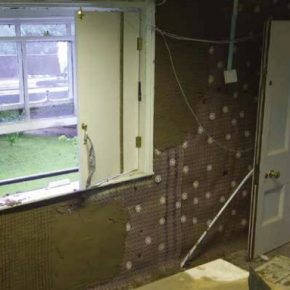
Delta Membranes: What do we mean by Types A, B & C Waterproofing?
Waterproofing is the process of making an object or structure waterproof or water-resistant, so it remains relatively unaffected by water or resisting the ingress of water under specified conditions. Buildings all around the world rely on structural waterproofing systems. Delta Membranes takes an insightful look…
The difference between waterproof and damp proof?
Waterproof refers to the penetration of water (in its liquid state) and possibly under pressure. Structural waterproofing is a general term within the industry that covers methods and treatments to describe waterproofing any structure.
Waterproofing or Structural Waterproofing is applicable to any construction under-ground or below ground level.
Damp proof refers to resistance to humidity or dampness.
Damp proofing is a general term that covers methods and treatments used to prevent damp from being absorbed through walls or floors into the interior of a structure above ground.

BS8102:2009
BS8102:2009 Code of Practice for the Protection of Below Ground Structures Against Water from the Ground is the British Standard which gives recommendations and provides guidance on methods of dealing with and preventing the entry of water from surrounding ground into a structure at below ground level.
It states that there are 3 types of waterproofing protection:
Type A (Barrier) Protection
Type A (Barrier) Protection, also historically referred to as ‘Tanking’, provides protection against ground water ingress by applying a waterproof material to the internal or external walls and floor slab of a basement or underground structure forming a barrier between the structure and any groundwater present.
Historically, methods for Type A systems included internal, external and sandwich.
Type B (Structurally Integral) Protection
Type B protection is provided by the structure itself against water ingress. Type B Protection relies heavily on the design and materials incorporated into the external shell of the structure.
Design, materials, as well as the quality of the workmanship contribute to the success of Type B Systems. The pattern of any seepage encountered is often associated with poor joints, cracks or other discontinuities such as service penetrations.
Type C (Drained) Protection
Type C protection is provided by the incorporation of an appropriate internal water management system.
Type C Protection allows moisture or running water to penetrate through the external wall or floor of the structure and to travel behind the membrane in a controlled drainage system.
Type C systems collect and manage any water ingress by diverting it into a designated safe point of disposal (such as a sump pump/package pump station).
Cavity Drain Membranes are studded on the external facing surface, allowing any water that penetrates the structure to flow into designed drainage channels.
The drainage channels carry any water ingress to either a sump and pump chamber or away from the structure if passive drainage is possible.
Delta Membrane Systems,
Delta House,
Merlin Way,
North Weald,
Epping,
Essex,
CM16 6HR
United Kingdom
Visit Delta Membrane Systems' website
Visit Supplier's page
Latest news

26th July 2024
Enfield Speciality Doors completes world-class project for Atlas Copco HQ
A rundown office and warehouse building completely transformed into a modern headquarters for Atlas Copco has been fitted with more than 120 internal fire doors from Enfield Speciality Doors.
Posted in Access Control & Door Entry Systems, Articles, Building Industry News, Building Products & Structures, Building Systems, Case Studies, Doors, Interior Design & Construction, Interiors, Posts, Restoration & Refurbishment, Retrofit & Renovation, Security and Fire Protection, Sustainability & Energy Efficiency, Timber Buildings and Timber Products, Wooden products
26th July 2024
Abloy UK launches new white paper
Abloy UK, a leading provider of security and access control solutions, has launched a new white paper.
Posted in Access Control & Door Entry Systems, Architectural Ironmongery, Articles, Building Industry News, Building Products & Structures, Building Services, Doors, Facility Management & Building Services, Health & Safety, Information Technology, Innovations & New Products, Publications, Research & Materials Testing, Security and Fire Protection
26th July 2024
MCRMA Member Profile: David Roy, Director of Roofconsult
David Roy of MCRMA member company Roofconsult has more than 50 years’ experience to draw upon working in the building envelope sector and a unique perspective on how it has changed in that time.
Posted in Articles, BIM, Infrastructure & CAD Software, Building Associations & Institutes, Building Industry News, Building Products & Structures, Building Services, Building Systems, Cladding, Information Technology, Restoration & Refurbishment, Retrofit & Renovation, Roofs, Walls
26th July 2024
Strand: Enhancing Door Functionality and Safety
Craig Fox, Sales Director for Strand Hardware, outlines how door industry professionals might apply door limiting stays…
Posted in Architectural Ironmongery, Articles, Building Industry News, Building Products & Structures, Building Services, Doors, Facility Management & Building Services, Health & Safety, Restoration & Refurbishment, Retrofit & Renovation
 Sign up:
Sign up: